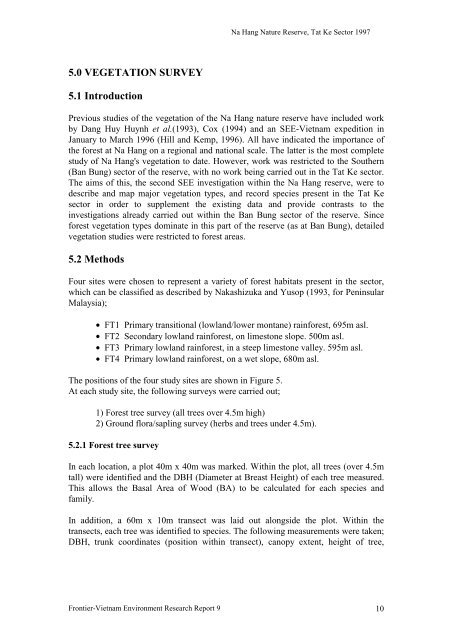Na Hang Nature Reserve, Tat Ke Sector - Frontier-publications.co.uk
Na Hang Nature Reserve, Tat Ke Sector - Frontier-publications.co.uk
Na Hang Nature Reserve, Tat Ke Sector - Frontier-publications.co.uk
Create successful ePaper yourself
Turn your PDF publications into a flip-book with our unique Google optimized e-Paper software.
<strong>Na</strong> <strong>Hang</strong> <strong>Na</strong>ture <strong>Reserve</strong>, <strong>Tat</strong> <strong>Ke</strong> <strong>Sector</strong> 1997<br />
5.0 VEGETATION SURVEY<br />
5.1 Introduction<br />
Previous studies of the vegetation of the <strong>Na</strong> <strong>Hang</strong> nature reserve have included work<br />
by Dang Huy Huynh et al.(1993), Cox (1994) and an SEE-Vietnam expedition in<br />
January to March 1996 (Hill and <strong>Ke</strong>mp, 1996). All have indicated the importance of<br />
the forest at <strong>Na</strong> <strong>Hang</strong> on a regional and national scale. The latter is the most <strong>co</strong>mplete<br />
study of <strong>Na</strong> <strong>Hang</strong>'s vegetation to date. However, work was restricted to the Southern<br />
(Ban Bung) sector of the reserve, with no work being carried out in the <strong>Tat</strong> <strong>Ke</strong> sector.<br />
The aims of this, the se<strong>co</strong>nd SEE investigation within the <strong>Na</strong> <strong>Hang</strong> reserve, were to<br />
describe and map major vegetation types, and re<strong>co</strong>rd species present in the <strong>Tat</strong> <strong>Ke</strong><br />
sector in order to supplement the existing data and provide <strong>co</strong>ntrasts to the<br />
investigations already carried out within the Ban Bung sector of the reserve. Since<br />
forest vegetation types dominate in this part of the reserve (as at Ban Bung), detailed<br />
vegetation studies were restricted to forest areas.<br />
5.2 Methods<br />
Four sites were chosen to represent a variety of forest habitats present in the sector,<br />
which can be classified as described by <strong>Na</strong>kashiz<strong>uk</strong>a and Yusop (1993, for Peninsular<br />
Malaysia);<br />
• FT1 Primary transitional (lowland/lower montane) rainforest, 695m asl.<br />
• FT2 Se<strong>co</strong>ndary lowland rainforest, on limestone slope. 500m asl.<br />
• FT3 Primary lowland rainforest, in a steep limestone valley. 595m asl.<br />
• FT4 Primary lowland rainforest, on a wet slope, 680m asl.<br />
The positions of the four study sites are shown in Figure 5.<br />
At each study site, the following surveys were carried out;<br />
1) Forest tree survey (all trees over 4.5m high)<br />
2) Ground flora/sapling survey (herbs and trees under 4.5m).<br />
5.2.1 Forest tree survey<br />
In each location, a plot 40m x 40m was marked. Within the plot, all trees (over 4.5m<br />
tall) were identified and the DBH (Diameter at Breast Height) of each tree measured.<br />
This allows the Basal Area of Wood (BA) to be calculated for each species and<br />
family.<br />
In addition, a 60m x 10m transect was laid out alongside the plot. Within the<br />
transects, each tree was identified to species. The following measurements were taken;<br />
DBH, trunk <strong>co</strong>ordinates (position within transect), canopy extent, height of tree,<br />
<strong>Frontier</strong>-Vietnam Environment Research Report 9 10
















